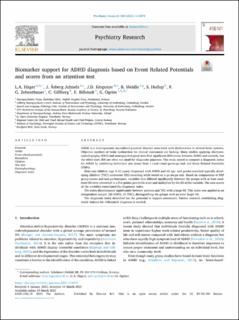| dc.contributor.author | Häger, Linda Angelica | |
| dc.contributor.author | Johnels, Jakob Åsberg | |
| dc.contributor.author | Kropotov, Juri D. | |
| dc.contributor.author | Weidle, Bernhard | |
| dc.contributor.author | Hollup, Stig Arvid | |
| dc.contributor.author | Zehentbauer, Peter Georg | |
| dc.contributor.author | Gillberg, Christopher | |
| dc.contributor.author | Billstedt, Eva | |
| dc.contributor.author | Øgrim, Kjell Geir | |
| dc.date.accessioned | 2021-07-12T10:40:20Z | |
| dc.date.available | 2021-07-12T10:40:20Z | |
| dc.date.created | 2021-07-08T14:55:52Z | |
| dc.date.issued | 2021 | |
| dc.identifier.citation | Psychiatry Research. 2021, 300, . | en_US |
| dc.identifier.issn | 0165-1781 | |
| dc.identifier.uri | https://hdl.handle.net/11250/2764151 | |
| dc.description.abstract | ADHD is a heterogeneous neurodevelopmental disorder associated with dysfunctions in several brain systems. Objective markers of brain dysfunction for clinical assessment are lacking. Many studies applying electroencephalography (EEG) and neuropsychological tests find significant differences between ADHD and controls, but the effect sizes (ES) are often too small for diagnostic purposes. This study aimed to compute a diagnostic index for ADHD by combining behavioral test scores from a cued visual go/no-go task and Event Related Potentials (ERPs). Sixty-one children (age 9–12 years) diagnosed with ADHD and 69 age- and gender-matched typically developing children (TDC) underwent EEG-recording while tested on a go/no-go task. Based on comparisons of ERP group-means and task-performance, variables that differed significantly between the groups with at least moderate ES were converted to a five points percentile scale and multiplied by the ES of the variable. The sum-scores of the variables constituted the diagnostic index. The index discriminated significantly between patients and TDC with a large ES. This index was applied to an independent sample (20 ADHD, 21 TDC), distinguishing the groups with an even larger ES. The diagnostic index described has the potential to support assessment. Further research establishing diagnostic indexes for differential diagnoses is needed. | en_US |
| dc.language.iso | eng | en_US |
| dc.publisher | Elsevier Ltd. | en_US |
| dc.rights | Attribution-NonCommercial-NoDerivatives 4.0 Internasjonal | * |
| dc.rights.uri | http://creativecommons.org/licenses/by-nc-nd/4.0/deed.no | * |
| dc.title | Biomarker support for ADHD diagnosis based on Event Related Potentials and scores from an attention test | en_US |
| dc.type | Peer reviewed | en_US |
| dc.type | Journal article | en_US |
| dc.description.version | publishedVersion | en_US |
| dc.source.pagenumber | 0 | en_US |
| dc.source.volume | 300 | en_US |
| dc.source.journal | Psychiatry Research | en_US |
| dc.identifier.doi | 10.1016/j.psychres.2021.113879 | |
| dc.identifier.cristin | 1921048 | |
| dc.description.localcode | This article is available under the Creative Commons CC-BY-NC-ND license and permits non-commercial use of the work as published, without adaptation or alteration provided the work is fully attributed. | en_US |
| dc.source.articlenumber | 113879 | en_US |
| cristin.ispublished | true | |
| cristin.fulltext | original | |
| cristin.qualitycode | 1 | |

